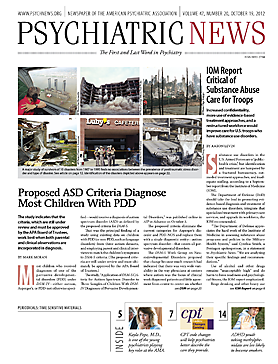Study Finds Antidepressants Increase Accident Risk
Taiwanese researchers found a significant risk of motor-vehicle accidents (MVAs) in patients who had taken an antidepressant within the prior month. They examined the relationship between MVAs and exposure to four classes of psychotropic drugs including antipsychotics (typical and atypical), antidepressants (both selective serotonin reuptake inhibitors and tricyclics), benzodiazepines (BZDs; long-acting, short-acting, hypnotics, and anxiolytics), and “Z-drugs,” a class that includes zolpidem, zolpiclone, and zaleplon. Their study included 5,183 subjects with MVAs and 31,093 matched controls, identified from the claims records for outpatient service visits from the National Health Insurance Research Database in Taiwan from 2000 to 2009.
Significant increased risk of MVAs was found in those taking antidepressants within one month, one week, and one day before MVAs occurred. Similar results were observed in subjects taking benzodiazepines and Z-drugs, but not antipsychotics. Moreover, significant dose effects of antidepressants, BZDs, and Z-drugs were observed on the risk of experiencing an MVA.
“It is of importance that physicians and pharmacists provide their patients with accurate advice, choose safe, alternative treatments, and advise patients not to drive, especially while taking medications, to minimize the risk of causing MVAs under the influence of psychotropic medications,” warned the researchers.
Chang C, Wu E, Chen C, et al. “Psycho-tropic Drugs and Risk of Motor Vehicle Accidents: A Population-Based Case-Control Study.” Br J Clin Pharmacol. 2012. Sep 12 [Epub ahead of print]. www.ncbi.nlm.nih.gov/pubmed/22971090 Obese Youth Have Less Taste Sensation
Obese children have less-sensitive taste buds than kids of normal weight, say researchers at Charite Universitatsmedizin in Berlin, Germany, and this blunted ability to distinguish all five tastes of bitter, sweet, salty, sour, and umami (savory) may prompt them to eat larger quantities of food in an attempt to register the same taste sensation.
They studied the gustatory sensitivity of 99 obese subjects, defined as those having a body mass index (BMI) greater than the 97th percentile, and of 94 normal-weight subjects (BMI less than the 90th percentile), aged 6 to 18. Sensitivity for the taste qualities sweet, sour, salty, umami (savory), and bitter was determined using impregnated “taste strips” in different concentrations. A total score was determined for all taste qualities combined as well as for each taste quality separately, and the possible influence of gender, age, and ethnicity were considered. The sum of all five taste sensations at the four different intensities allowed for a maximum score of 20, with scores ranging from 2 to 19. Each child was asked to refrain from eating or drinking anything other than water and not to chew gum for at least an hour before taking the two tests, which involved identifying the different tastes and their intensities.
They found that girls and older children were better at picking out the right tastes. Overall, the children were best able to differentiate between sweet and salty, but found it hardest to distinguish between salty and sour, and between salty and umami. Obese children found it significantly more difficult to identify the different taste sensations, scoring an average of 12.6 compared with an average of just over 14 by children of normal weight. And while both obese and normal weight-children correctly identified the differing levels of sweetness, obese children rated 3 out of the 4 intensity levels lower than youth of normal weight.
Similarly, children of normal weight were better able to distinguish the different taste sensations with increasing age, but this trend was not seen among obese children. Exactly why people have differing taste perceptions is unclear, but genes, hormones, acculturation, and exposure to different tastes early in life are all thought to play a part, said the authors.
Prenatal Exposure to Smoking Promotes Adolescent Obesity
Pregnant women who smoke may be sentencing their child to adolescent obesity, in part due to subtle structural variations in the child’s amygdala. Researchers based at the University of Toronto evaluated 378 adolescents enrolled in the Saguenay Youth Study in Quebec, Canada. Half of the subjects were exposed prenatally to maternal cigarette smoking, and those teens exhibited a higher total body fat than peers who were not exposed. They also exhibited lower amygdala volume. Consistent with its possible role in limiting fat intake, amygdala volume correlated inversely with fat intake.
The study population had high genetic and cultural homogeneity, and there was no difference between drug-exposed and nonexposed participants on factors such as number of family meals, intake of fruits and vegetables, and family income.
The researchers said their findings are consistent with the fetal-programming hypothesis of obesity and suggest that prenatal exposure to maternal cigarette smoking may contribute by modifying fat intake through neural mechanisms involving the amygdala.
Smoking-Cessation Anxiety Boosts Urge to Smoke
Researchers at the Edith Nourse Rogers Memorial Veterans Hospital in Bedford, Mass., recently sought to determine how anxiety characteristics are related to smoking-cessation outcomes in alcohol-dependent smokers.
They studied 83 alcohol-dependent smokers who were part of a larger smoking-cessation clinical trial and examined associations between anxiety sensitivity, trait anxiety, nicotine withdrawal symptoms, smoking urges, and smoking-cessation outcomes. Smoking-cessation treatment was administered in a three-week cognitive-behavioral format that included eight weeks of open-label nicotine-patch treatment. Information on nicotine withdrawal, smoking urges, and CO-confirmed smoking consumption rates was collected at baseline, quit date, end of behavioral treatment, and a one-month follow-up.
At the quit date, 63.4 percent of participants were CO-confirmed smoking abstinent. At the end of treatment, 45.1 percent were confirmed abstinent, and at the one-month follow-up, 35.0 percent were abstinent. Levels of trait anxiety were particularly elevated in the group overall, and both anxiety sensitivity and trait anxiety were positively associated with the level of nicotine dependence.
Higher levels of anxiety sensitivity were associated with more smoking urges due to anticipation of negative affect relief at quit date. Higher levels of trait anxiety were associated with more smoking urges due to positive reinforcement and anticipation of relief of negative affect at quit date, as well as more severe nicotine withdrawal symptoms at the end of treatment.
Their study, the researchers said, supports the importance of targeting anxiety-related factors in cessation attempts for alcohol-dependent smokers. The more anxious they generally are, the more likely they are to have smoking urges related to positive reinforcement, anticipation of relief of negative affect, and more severe nicotine withdrawal symptoms.”
Kelly M, Grant C, Cooper S, et al. “Anxiety and Smoking Cessation Outcomes in Alcohol-Dependent Smokers.” Nicotine Tob Res. 2012. September 6 [Epub ahead of print]. www.ncbi.nlm.nih.gov/pubmed/22955245 

